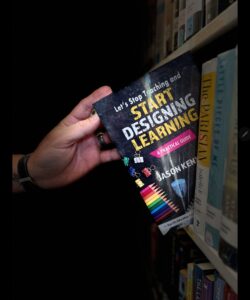The year’s winding down. The bulletin boards are starting to come down. Desks are being cleaned out. Awards are being handed out. And for a few fleeting moments, it’s quiet. But before we rush off to the lake or start planning PDs for next year, I want to ask a simple, but loaded, question:
What was most of your work about this year? Teaching work? Or learning work?
Because here’s the thing I’ve learned: designing for learning isn’t more work. It is the work. It’s the work that works. It’s the only work that guarantees the work we’re doing matters. If we’re honest, a lot of the effort we’ve put in this year may not have led to what we were actually hired to deliver: learning. It’s not a jab. It’s a mirror. And we owe it to ourselves to take a long look.
Teaching Work vs. Learning Work
Let’s name it: teaching and learning are not the same thing. They’re related. But they’re not interchangeable. Most of us, myself included, have spent years thinking they were. I used to believe that if I taught it well, then of course my learners had learned it. I had the PowerPoint, the example, the enthusiasm. I had great classroom management. I had systems. But what I didn’t always have? Learning. Because teaching isn’t evidence of learning. Compliance isn’t proof that thinking happened.
Teaching work is important. It’s the prep, the planning, the materials, the classroom routines. But it isn’t always learning work. Learning work is about what learners do, not what we say. It’s measured in what they can transfer, explain, defend, and apply. I’ve stood in front of a room and taught an “airtight” lesson, only to realize three days later during a formative check that no one could explain what the point of it was. That’s when I started asking a different question: “If they aren’t learning, is it their doing or is it my design?” That question shifted everything.
Designing Is Not More Work; It’s Different Work
Let’s tackle the myth: Designing learning isn’t an add-on. It’s not Pinterest-level extras for those unicorn teachers who have “more time.” It’s not a bonus round if we have energy left. It’s not the icing. It’s the whole cake. The truth is, teaching the way we’ve always done it often requires more energy: constant redirection, constant talking, constant reteaching. And what do we get back in return? Exhaustion. Frustration. And, too often, disengaged learners.
When we design learning, we shift the ownership where it belongs: onto the learners. We craft tasks that let them engage with the content, collaborate around it, and create from it. We structure choice, embed feedback, and make success criteria transparent. According to Hattie’s Visible Learning research, elements like teacher clarity (0.84), feedback (0.75), and self-reported grades (1.33) have powerful impacts on achievement. These aren’t instructional decorations. These are design decisions. And when we build them into the bones of our lessons, we stop performing and start facilitating. We stop doing all the work, and they start doing the thinking.
Design isn’t about flashy tools or perfection. It’s about intention. It’s about laying a foundation where learners aren’t just handed content but are invited into the cognitive work of learning. When learning is designed, learners move. They talk. They make mistakes and revise. They start asking their own questions instead of just answering ours. That’s not magic. That’s what happens when we stop centering ourselves as performers and start engineering experiences where learning is visible, ownable, and real.
Learning Is the Job
We don’t get paid to teach. We get paid for learning to happen. That’s a hard truth I had to learn over time. I used to walk out of my classroom feeling proud that I had “delivered a great lesson.” And then one day it hit me: the delivery might’ve been flawless, but the package never got opened. The content might’ve been on point, but if it never got into learners’ heads and if it never turned into understanding, then what exactly did I accomplish?
Learning is the reason the school was built. It’s the reason every line item in the budget exists. If there’s no learning, nothing else matters. When I started leading with that in mind, everything shifted. My walk-throughs weren’t just about checking for standards posted or engagement strategies being used. I started asking, “What are learners learning right now and how do they know?” The answers were revealing. Sometimes inspiring. Sometimes uncomfortable. But always necessary.
Learning must be the filter. If something we’re doing doesn’t lead to learning, or better yet, transfer, it’s time to question why we’re doing it. When we embrace this mindset, it changes how we plan, how we facilitate, how we collaborate, and how we lead. It becomes the non-negotiable. Not test prep. Not compliance. Not just “covering” the curriculum. Learning. Because if we want learners to think deeply, communicate clearly, solve creatively, and collaborate meaningfully, we have to design classrooms where those things aren’t optional, they’re expected.
The Reflection That Matters Most
So as this year closes, I’m not asking you to list what you taught. I’m asking you to reflect on what your learners learned because of what you designed. Did you give them opportunities to struggle, revise, reflect, and grow? Did they leave your classroom more capable, more curious, more equipped to handle complexity?
This job is hard. Always has been. Always will be. But the kind of hard we choose matters. Designing for learning is the hard that leads to progress. It’s the hard that leads to growth. It’s the hard that is worth it. So let’s choose the work that works. Let’s choose the kind of work that sends learners home tired, not because they were compliant, but because they were cognitively stretched. Let’s choose learning.
And let’s design like that is the only thing that matters because it is.


